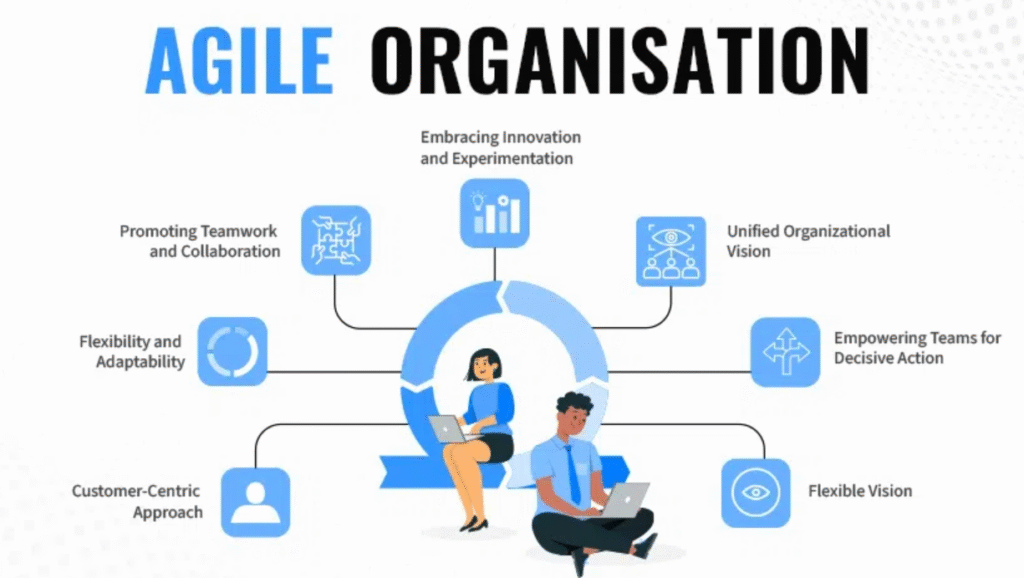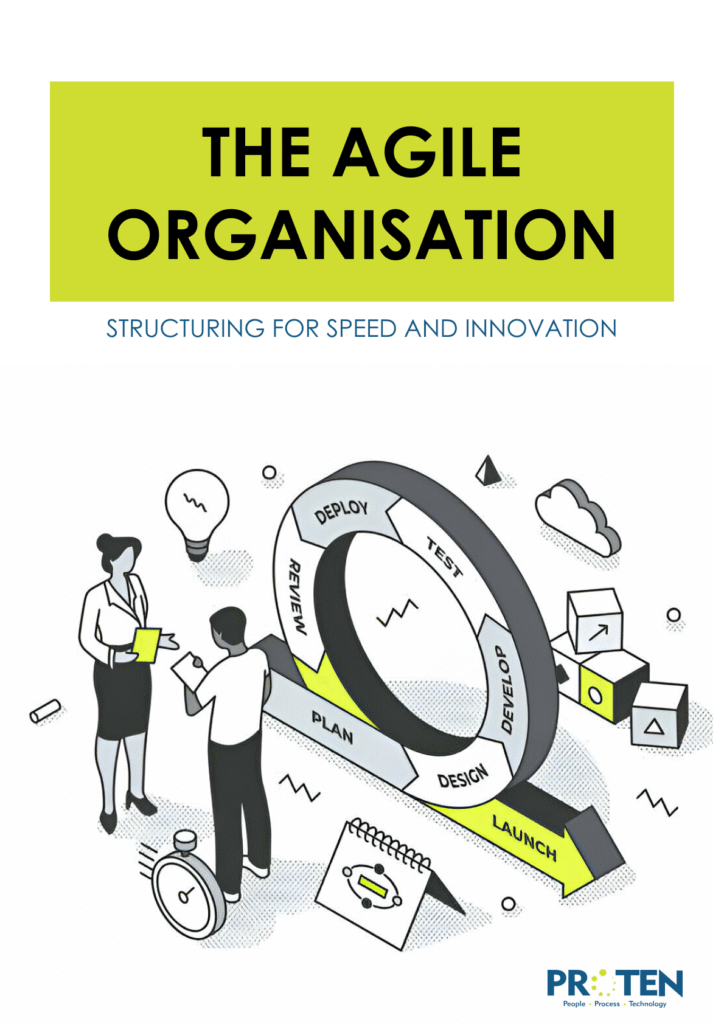A Greek philosopher of the late 6th century BC, Heraclitus, said that “change is the only constant,” having observed that change is a fundamental aspect of the world and reality. This observation has never been more true than in modern times, as we watch the rate of change accelerate rapidly.
The modern business landscape is marked by rapid technological advancements, shifting consumer expectations, and geopolitical uncertainties. Traditional hierarchical organisations, designed for stability and predictability, struggle to keep pace with the rapid changes. According to a WTW study, 70% of change initiatives fail. In a similar survey by LeadershipIQ, 31% of CEOs get fired for poor change management.
In tackling the never-ending dilemma of rapid change, the Agile Organisation framework offers a solution: a structure optimised for speed and innovation, rooted in principles originally developed in software development but now applied across industries.
An Agile Organisation is one that can swiftly respond to market changes, deliver value to customers iteratively, and foster a culture of continuous improvement. The subsequent pages of this treatise delve into how organisations can achieve this through intentional design and cultural transformation.
Core Principles of Agile Organisations

Source: GeeksforGeeks
Agile organisations operate differently from traditional ones. Rather than planning long-term projects with sequential tasks, Agile teams break projects into smaller, manageable parts. Additionally, Agile organisations minimise heavy documentation, using concise user stories to capture project requirements. This approach enhances efficiency, helping businesses save both time and money.
Agility is not a one-size-fits-all model but a mindset supported by key principles:
- Customer-Centricity: The original formulation of the Agile principle was coined around customer satisfaction through early and continuous delivery. This means that customer satisfaction was at the heart of the Agile framework.
Agile organisations prioritise customer needs, using data and feedback to drive decisions. For example, Amazon’s obsession with customer experience exemplifies this principle.
- Iterative Processes: The iterative process involves the practice of building, refining, and improving a project, product, service, or initiative. This approach was first developed and deployed in software development but has been adapted for application in many areas of organisational management.

Source: Imaginary Cloud
Borrowing from Agile software methodologies like Scrum and Kanban, organisations can deliver products and services in small, testable increments rather than large, risky launches.
- Empowered Teams: Empowerment within agile teams describes a work environment where employees are given autonomy to make decisions regarding their work, creating an environment where innovation and creativity can thrive.
Bureaucratic bottlenecks are often associated with rigid hierarchical organisations. This can be counterproductive as decision-makers are sometimes disconnected from the reality on the ground. Decentralised decision-making empowers cross-functional teams to act quickly without bureaucratic delays.
- Flexibility: Agile methods create teams that are adaptable to changing requirements, customer needs, market conditions, and black swan events. Flexibility is a key feature of the Agile framework as its unique selling point is the ability of organisations to respond swiftly to a changing business landscape. Agile organisations pivot as needed, reallocating resources to seize opportunities or mitigate risks.
Structural Elements of Agility
Agile companies tackle challenges through their organisational structure, ensuring that every team member actively contributes to the company’s evolution. Rather than assigning problem-solving efforts to a select group of employees, Agile organisations involve everyone, fostering collaboration and shared responsibility in shaping the business. Some elements of Agile structures include:
- Flat Hierarchies: Agile organisations adopt a flatter hierarchy compared to traditional structures, enabling decentralised decision-making. By granting teams autonomy and empowerment at all levels, this approach fosters a culture of ownership and drives innovation throughout the organisation. By minimising layers of management, communication and decision-making can be accelerated within the organisation.
- Cross-Functional Teams: The cross-functional team feature of Agile organisations works hand-in-hand with the flattened hierarchy to build efficient teams working in a close-knit working environment. This setup creates teams composed of individuals with diverse skill sets (e.g., marketing, engineering, design) who can collaborate on end-to-end delivery of products and services, reducing silos.
- Dynamic Resource Allocation: Budgets and talent are fluid, shifting to high-priority projects as needs evolve. The ability to allocate resources (human and material) in a dynamic manner, in adaptation to changes within the project is an essential structural feature of Agile organisations.
- Technology as an Enabler: Leveraging technological tools and platforms enhances collaboration, productivity, and transparency in Agile teams. Project management software, communication tools, and collaborative platforms streamline task coordination and information sharing. By integrating technology, teams can optimise workflows, track progress, and identify areas for improvement, ultimately driving project success. Tools like AI-driven analytics, cloud computing, and collaboration platforms (e.g., Slack, Jira) underpin agility.
- Culture of Experimentation: A culture of experimentation is necessary to provide the environment for employees to be curious, creative, and try out new ideas. The feedback from such creative endeavours can be used to improve products and services. Failure is reframed as learning, with organisations like Google encouraging “20% time” for innovation.
Case Studies
- Spotify: The music streaming giant pioneered the “Squad” model, organising small, autonomous teams around specific features (e.g., search, playlists). Squads operate within “Tribes” (larger groups aligned to a mission) and “Guilds” (communities of practice), balancing autonomy with alignment.

Source: ResearchGate
- ING: The Dutch bank transformed its operations by adopting an agile structure inspired by Spotify. By 2023, ING reported faster product delivery and higher employee engagement.
- Tesla: Tesla’s ability to innovate rapidly—such as iterating on vehicle software over-the-air—demonstrates agility at scale, driven by a flat structure and a relentless focus on first principles.
Challenges in Becoming Agile
According to Simform, 30% of organisations face a minimum of 10 agile adoption challenges. Organisations new to the Agile framework often encounter some difficulty during execution. However, with foresight and determination, these hurdles can be successfully navigated. Some of these challenges include:
- Resistance to Change: A key challenge in transitioning to the Agile team method is resistance to change. Employees accustomed to rigid roles may resist empowerment or ambiguity. Also, Teams may hesitate to adopt new methodologies, fearing workflow disruptions or increased workload. To address this, organisations should prioritise open communication and a productivity-focused approach to ease the transition.
- Balancing Structure and Chaos: For a system to be innovative and efficient, it must find the right balance between the order of structure and the chaos of flexibility.
One common misconception about Agile team management is that it requires less structure; this is not true. To prevent chaos and misalignment in the implementation of the Agile method, organisations should establish clear roles, processes, and frameworks while prioritising continuous improvement and alignment with strategic objectives.
- Scaling Agility: Scaling and coordination in large Agile teams is one of the primary challenges of the Agile management method. Large organisations face complexity in coordinating thousands of employees across geographies, and some team members may lack the knowledge of how Agile works.
8. Conclusion
Source: Collab
Adopting the Agile organisational model is not merely pursuing a fancy trend but a strategic necessity for companies aiming to thrive in today’s fast-changing and uncertain economic climate. By empowering teams, fostering a culture of innovation, and prioritising customer-centricity, Agile organisations position themselves for long-term success and a competitive edge in the digital age.
Agility represents a fundamental shift in organisational mindset and strategy. It requires commitment, adaptability, and a readiness to embrace change. Businesses that fully integrate Agile principles can unlock their potential, drive innovation, and navigate uncertainty, ultimately achieving sustained growth and success in today’s fluxional business landscape.
How Proten International Can Help
There are different methods such as Scrum, Kanban, and SAfe. The principles of Agile methodologies are very flexible and can be applied by different organisations.
However, to make a successful Agile transformation, you need to have the necessary foundation. Proten International can help you speed up your agile transformation and improve your ROI. We are ready to help guide you on this transformative journey.
Contact us today.

